Olympic National Park
Olympic is often overshadowed by Mount Rainier National Park given their close proximity but you won’t be disappointed if you take the time to visit Olympic National Park as well while you are in Washington state. No where else in America are you going to find a place which has glacier covered mountains, rain forests, beautiful lakes, and ocean coastline. Unlike some parks where you can drive the park road in an hour or two, it takes over 6 hours to loop around this park if you did nothing but drive the approximately 300 miles. The good news is there are plenty of towns just outside of the park and many campsites in or around the park, so you have plenty of options if you want to stay and focus on certain areas.
Most Recent Visit
August 2020
When to Go
It really depends on what you plan to do at this park. Like we mentioned above, you could see a range of ecosystems and all of them come with different weather. If you visit in the winter and want to go up to the mountain area obviously you should be a fan of snow and have a proper 4×4 vehicle and attire. You could still go out to the coast or the rain forest and still be able to experience everything they have to offer in the winter. Clearly it rains a lot here, especially in the rainforest area. If we had to choose a time of year, it would probably be the July-September months. There are still snowcapped mountains thanks to the glaciers, and you are likely to have your best weather of the year in these months. In addition, this is the best time to visit Washington’s other two National Parks so you might as well visit them all!
How to Get Here
Getting to the Olympic National Park is pretty simple, fly to Seattle and rent a car. Every major airline flies here and once you get your rental car it is about 2-3 hours to get to about any spot in the park depending on traffic. Keep in mind that in the summer months, traffic can get out of hand especially on Friday afternoons as everyone in the city disperses to the wilderness. While you are at it remember that Mount Rainier National Park and North Cascades National Park are also within a few hours’ drive of either the airport or Olympic. If you want to extend your vacation, you can incorporate them as well as a stay downtown Seattle to check out iconic sights like Pike Place Market and the Space Needle.
Trip Length
This park is quite large, so while you could pick one area and say you visited Olympic, you won’t get the full experience unless you stay 2-3 days at least. At a minimum, you should try to spend several hours, if not a full day, experiencing each ecosystem in the park (mountains, coast, rainforests). If you end up with extra time, there are tons of things to do in Washington state. Whether it be more National Parks like Mount Rainier or North Cascades, sightseeing in Seattle, or even visiting Mount Saint Helens to see the destruction of that volcanic eruption. You will have plenty to keep you busy.
Where to Stay
It is really hard to have a home base at this park because it is just so expansive. You’ll spend more than half the day driving if you try to lodge in one spot and want to see the other side of the park. You can pull off two spots though to limit the times you have to repack everything up. We would recommend staying a night in Port Angeles which has easy access to the most popular area of the park, Hurricane Ridge. There are tons of budget hotels here and if you want to camp there is a very large campground right after you get through the entrance Heart o’ the Hills entrance station. From here, you could move over to the Quinault area and stay a few nights. There are a couple reasonably priced lodging options here as well as more campgrounds and you will have easy access to the rain forest area of the park and will also only be 1-2 hours away from the best coastline areas as well which is a more manageable day trip (and you could hit this area on your way to Quinault from Port Angeles as well rather than doubling back later).
What to Do
As mentioned above, if you have the time you should try to visit each of the various ecosystems in the park: Mountains, Waterfalls/Lakes, Ocean Coast, and Rainforests. This is a large park and there likely will be quite a bit of driving also involved. Take your time and enjoy!
Hurricane Ridge Area (Mountains)
If you are staying the night before in Port Angeles, then you will have a nice short drive up to Hurricane Ridge (about 30 minutes). This is the most popular spot in the park and if you want to make sure you get a parking spot try to arrive before 10am. If you wait past that, there is a great chance you will find yourself sitting in an hour-long line at the Heart O’ the Hills entrance station. Once you get up to Hurricane Ridge, start by stopping in the visitor center which has some nice exhibits and also a gift shop and cafe.


Our favorite hike in this area actually requires you to drive a little bit further past the visitor center and main parking lot. You will wind down a narrow road and eventually come to the end of the road where there is a much smaller parking lot. This is the Hurricane Hill trailhead.
Hurricane Hill — 3.4 miles RT, Moderate, 1.5 hours
This trail is paved the entire way but don’t let that fool you. You are still going to climb ~700 feet and it felt like more than that to us. This is one of the more popular hikes in the park and certainly one of our favorites as well. Almost the entire time, you are going to have great views of the snow-covered Olympic Mountains which makes the steeper grades of the trail seem a little better. This is also supposed to be a stronghold for the Olympic Marmots which supposedly are often hear whistling along the trail. We say “supposedly” because we didn’t see a single one and were the first people out on the trail in the morning. These marmots must like to sleep in! We did see quite a few grouse, so we got some wildlife views in which is always a goal for Scott! Once you reach the top Hurricane Hill you will have an amazing view (on a clear day) with the Olympic Mountains behind you and views of Canada, the San Juan Islands, Mount Baker, and Port Angeles in front of you.


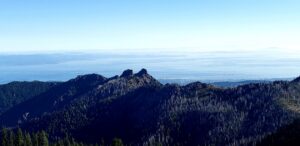

High Ridge Trail — 0.5 miles RT, Easy, 30 min
You can make your way back to the visitor center for this short hike. There is actually a short circuit of trails from the visitor center which all add up to less than a mile of walking if you add in the Cirque Rim Trail and the Big Meadows Trail. You can start the High Ridge Trail right from the parking lot or by taking one of these other connecting trails. Either way, there is a good chance you will see some deer standing or laying in the meadows right above the parking lot. Once you get to the High Ridge trail you are almost immediately going to be heading up 200 feet over the quarter mile. Once you reach the top you do have some more great views of the Olympics behind you and Mount Angeles in front of you as well as Port Angeles again. On your way back to the parking lot you could choose to take the 7.6-mile Klahhane Ridge trail which intersects and takes you to and up Mount Angeles. While it would have been a great workout, we didn’t feel like we would get any different views than we already got so we passed on this trail.


If you are more adventurous than us, there are opportunities for some really long (13+ mile) hikes down into the valley from Hurricane Ridge. These are all super steep descents which might be fine but climbing back out would be one heck of a challenge. We might try one someday but have passed for now!
There is one more hike in this vicinity, but it requires getting back in the car and heading back down near the entrance station to the Heart O’ the Hills Campground. Loop E is where the trail begins.
Heart O’ the Forest Trail — 4.0 miles RT, Easy, 2 hours
This is a cool hike as long as you don’t hike the whole trail. We know that sounds silly but trust us on this one. For the first mile or so, you walk through an old growth forest which is always interesting for us. You look up at these extremely large trees which have been standing for hundreds of years and think about all of the world events which have occurred while the trees stood here. It’s pretty crazy. It is also interesting to look at the fallen giants and there are a couple spots on the trail where the entire root system and base of the tree are on display for a selfie so your friends and family can try to comprehend how large these trees are. Around the mile mark you will reach a wooden walkway which is pretty lengthy and takes you over a swampy grassland area. This is your cue to turn around. Nothing beyond this point is going to be more interesting than what you have already seen. We were not as smart and kept going and it ended up in a pretty steep descent with overgrown vegetation onto the trail to a little creek. It would be one thing if the creek was relaxing but you can barely even see the creek as there are so many fallen trees over it. We passed by multiple hikers who told us to turn around, but we are stubborn and kept going anyway. Don’t make the same mistake as us!

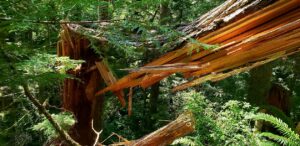
Lake Crescent Area (Waterfalls/Lakes)
Before you get to Lake Crescent, drive down the road towards Elwha until you get to the Madison Creek Falls area. When we were there, the road was actually closed beyond this point, so Madison Falls was as far as we could go via car. You were allowed to walk further down the road if you wanted. There is a short 0.2 mile walk to Madison Falls which is worth your time as it is a calming 50-foot waterfall that is very photogenic. When you get back to the parking lot, walk over to the other side of the road and check out the Elwha River which is also very photogenic.


Once you are done here, drive over to Lake Crescent. A boat would be the best way to see this beautiful glacially carved lake, but there are a few trails worth your while. We should also note that we have heard good things about the Spruce Railroad Trail, but this was closed due to a wildfire during our visit, so we will have to try that out another time.
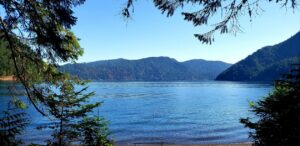

Marymere Falls – 1.8 miles RT, Easy, 1 hour
This is one of the more popular hikes in the park. Once you turn into the Lake Crescent area, follow the signs to Marymere Falls. There is a good-sized parking lot with a bathroom next to the Storm King Ranger Station. This is an easy walk to a beautiful waterfall. There is an upper and lower viewing area. We would recommend checking out both! The rest of the walk is through an old growth forest and is also worth your while. There is also an intersection where you can take the much more strenuous Mount Storm King trail which is 4.4 miles round trip (with ropes sections) but boasts a beautiful view.

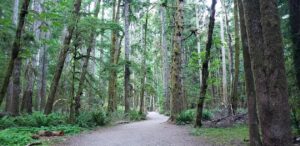
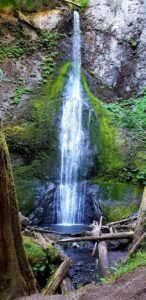
Moments in Time Trail – 0.7 miles RT, Easy, 30 minutes
This a nice walk which loops through old growth forest where you will see some giant trees, one of which is still standing despite being hollowed out at the base due to a past fire. Once you are through the forest, you will come out and walk along Lake Crescent which is a gorgeous lake. You will likely see plenty of boats out on the waters enjoying it if you are there in the non-winter months. Spend some time sitting on the beach and then head back to the car to continue on your journey.
Once you are back to your car, you are going to drive about 40 minutes past the Sul Doc Hot Springs Resort area to the Sul Doc trailhead for your next waterfall hike.


Sul Doc Falls – 1.6 miles RT, Easy, 1 hour
There are several hikes in this area that might be worth your while if you have time, but the one we chose was Sul Doc Falls. It is a relatively easy hike out to these powerful falls as you climb about 200 feet. It is worth it as you come to the falls which has water shooting down 3 or 4 columns. On the way, you will also start to understand that you are getting closer to the rainforest area as there is moss everywhere, on the ground and growing up and on trees. You will also walk through more old growth forest with some very tall trees.


Rialto / Ruby / Kalaloch Beach Area (Ocean Coast)
About an hour drive from the Sul Duc area, you will hit the ocean coast. You have lots of options here, but three beaches we believe you should give some serious consideration to are Rialto, Ruby, and Kalaloch. While there are some trails in these areas, the main focus is relaxing on the beaches with great views of several rock formations which the ocean waves crash into. One thing to keep in mind, while these are nice beaches, they are not going to be California or Florida style beaches. You will find a lot of debris and it can be quite cloudy/overcast many days out of the year.
Rialto Beach
If you were previously at Sul Duc, we would recommend starting your visit to the coast at Rialto Beach. It’s about an hour away and is a great spot to relax and take an afternoon nap if you have time (we did!). We got a really sunny day which is not a guarantee by any means, but it helped to show off the rock formations out in the water. Like many beaches in the Pacific Northwest, the beach is lined with washed-up trees. These can be quite fun to climb over on your walk to the water. The waves were very powerful the day we visited which is a very relaxing feeling and was the perfect backdrop for our afternoon nap.
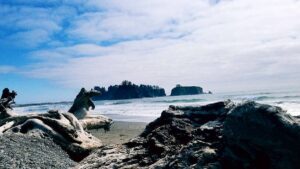

Ruby Beach
Ruby Beach is about an hour drive south from Rialto Beach. You will pass some other less known beaches on the way. This beach is more for walking along the water than it is for laying out and relaxing. In our experience, there are way more washed-up trees here and you will absolutely have to climb over them to get out to the water. Scott has been here twice and got one sunny day and one cloudy day, so it is hit or miss as expected. On our last visit, we actually came across quite the surprise as we walked along the water. It looked like a large rock at first, but as we got closer – it became clear that a whale had washed up on shore quite a while before we arrived. It had been dead for a long time, and we were quite surprised it hadn’t been removed given how many people walk up and down this beach. There are a number of rock formations in the water here as well and many of them are actually closer to shore than at Rialto.


Kalaloch Beach
Full disclosure, we have never been to this beach. It’s the most popular beach and because of that, it has always been so jammed packed by the time we got there that we decide to find another beach. We will make it someday and update this section. From the photos we have seen, this may be the closest beach to what you might expect from your typical touristy beaches. There is still a good number of washed-up trees and other debris, but there seems to be less than the beaches above.
Hoh and Quinault Rain Forest (Rainforests)
You have reached the final ecosystem in the park – the rainforest. There are several named rainforests here, but the two we have visited are the Hoh Rain Forest and the Quinault Rain Forest. The other main one, Queets, is the least visited section in this part of the park and therefore might be worth checking out if you are more interested in solitude during your journey.
Let’s start with the Hoh Rain Forest, the most popular rainforest in the park. You can stop by the visitor center here to talk to a ranger and check out some exhibits. Once you are done with that, there are a couple of easy trails we would highly recommend.
Hall of Mosses Trail – 0.8 miles RT, Easy, 45 minutes
For a trail that is less than a mile, this one is quite amazing. As its name implies, you are going to see moss absolutely everywhere. This is also an old growth forest with some monster trees and all of them are just draped in moss. You will exit this trail feeling like you truly just experienced a rainforest environment – which you did!

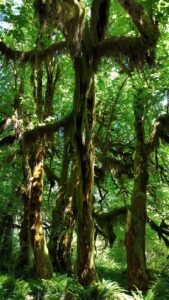
Spruce Nature Trail – 1.3 miles RT, Easy, 1 hour
Another short easy trail through an old growth forest. You would think you would be bored with this type of hike by now, but it is really hard not to be fascinated by these giants. In addition, you will find the world’s largest Sitka Spruce tree on this trail which is pretty cool.

For the more adventurous hiker, you can take the Hoh River trail which is over 18 miles one way out onto the Blue Glacier moraine with a view of Mount Olympus. You can turn this trail into a shorter day hike as there are several interesting sights and turnaround points. Talk to a ranger at the visitor center for more information if you are interested!
Quinault Rain Forest – This is where we recommended staying a night. There are a couple lodging options and also campsites right alongside Lake Quinault which will give you some really nice sunsets! Also, along Lake Quinault right next to the campsites is the World’s Largest Spruce Tree (as compared to the Sitka Spruce above). Stand next to this giant with your arms out to give everyone some perspective of just how large this tree is. There are also a couple shorter hikes in this area.




Kestner Homestead Trail – 1.3 miles RT, Easy, 1 hour
You’ll head to the other side of Lake Quinault for this hike which will take you back into the early 1800s as you walk through what used to be the Kestner Homestead. This place is almost frozen in time as you walk around the structures and vehicles still sitting on the homestead. You will walk along Kestner Creek on your way back through more old growth forest.


Maple Glade Trail – 0.5 miles RT, Easy, 30 minutes
This is an easy walk through a mossy grove of maple trees to cap off your time in Olympic National Park. You can actually include this loop trail with the Kestner Homestead trail above for a 1.5-mile loop trail if you wanted. From a wildlife standpoint – be on the lookout for elk along this entire loop. They are frequently seen – though we were not so lucky with this.
There are other trails in this area as well like Irely Lake trail which we have not done yet but have heard good things about. You can talk to a ranger for other ideas at the Quinault Forest Station.
If you have more time, there are other areas of Olympic we have not yet gotten too such as Staircase, Deer Park, and Dosewallips. All of these are likely worth checking out as well!
